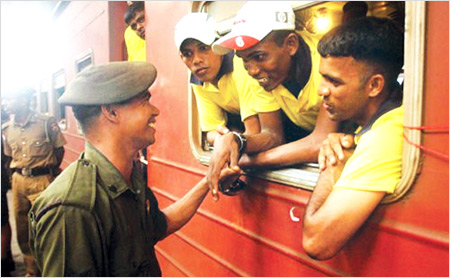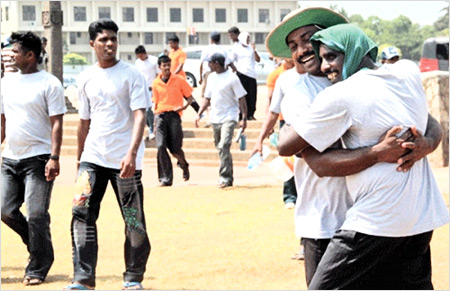|
Rehabilitation started immediately:
Reintegrating fighter cadres into society, no easy
task:
Rising like the phoenix from the ashes
Peaceful co-existence:
Historical relationship:
By Dhaneshi Yatawara

Infrastructure
development and resettlement are cumbersome, expensive and
time-consuming efforts yet changing the mindset of a fighter cadre and
reintegrating him/her to society would be the hardest. Rehabilitation of
those who fought for the terrorist organisation is obviously a crucial
part in the process of rising from the debris.
|
A mechanism
was designed to monitor the progress of those who have
reintegrated into society. Through this the Government restored
their livelihood and explore employment
opportunities. This was to ensure that when they returnvillages
they would lead normal lives as useful citizens and contribute
towards the development of the country. |
When nearly 11,000 ex-LTTE cadres surrendered to the Army after May
19, 2009, with support from the leader of the country, President Mahinda
Rajapaksa, the rehabilitation process started immediately with a solid
administrative structure.
At the initial stages 594 boys and girls between 12 and 18 were among
the surrendees. Of the adult youth, 3,658 were married and mostly men.
Though the majority were Hindus, there were 814 Christians, three
Muslims and six Buddhists. The intention was to teach them to respect
people and live peacefully with the community.
The rehabilitation process comprised psychological assistance,
education, sports, and spiritual, religious and cultural empowerment.
Following a recommendation by the Lessons Learnt and Reconciliation
Commission (LLRC), a special committee was appointed to study the cases
of detained LTTE suspects and expedite legal action where necessary, the
National Plan of Action for the Implementation of LLRC Recommendations
said in a statement.
There was a time, where our previous generations or even before that,
young children from the South used to stay with families in Jaffna,
Mullaitivu, Kilinochcchi and Vavuniya.
 |
|
LTTE cadres returning after
rehabilitation |
This helped build a close understanding between communities, leading
to the peaceful co-existence of all communities. Similarly, Tamil youth
stayed with Sinhala families. This way, both enjoyed each other's
culture, food, traditions and even their feelings.
This helped strengthen the historical relationship between the two
communities. Unfortunately, this good relationship came to a standstill
because of LTTE terrorists and it was so unfortunate that these youth
who were born after the 1980s have never experienced this interaction
with the Sinhala community. The main intention of arranging these trips
was to revamp that interaction between them. On the other hand, they
also can see the developments taking place in the South.
Changing
Over 90 percent of the ex-LTTE cadre didn't have the opportunity to
interact with those from the South. All their lives they believed the
wrong picture which was painted by the LTTE.
They had been brainwashed by the LTTE about the Sinhalese and the
Security Forces. The LTTE had propagated myths about Sinhalese people
being revengeful, as those who hated Tamils and were grabbing their
lands.
The misled youth were told that the Sinhalese wanted to chase the
Tamils from the North, to make Sinhala colonies there.
They were motivated to fight against the Sinhalese and the Security
Forces.
During the rehabilitation period of these youth focus was on many
aspects; giving them facilities for meditation, sports, educational and
vocational training topped the list. Ex-combatants were immediately
separated from the rest of the displaced persons and were transferred to
makeshift centres for their own security until proper Protective
Accommodation and Rehabilitation Centres (PARCs) were established.
Twenty-four PARCs were developed at the initial stages and functioned
separately for children, women and men.
Consent of these surrendered ex-combatants was taken to follow the
rehabilitation program - and all had to be documented. A dedicated
Competent Authority was appointed to attend to all matters relating to
the rehabilitation of ex-combatants.
Under the direction of President Rajapaksa, experts in the field set
goals within a conceptualised framework for the rehabilitation process
with coordinated and integrated efforts towards a comprehensive action
with clear directions and focus. Policies, the National Action Plan and
legal framework to facilitate the set goals were soon established,
ensuring that this process was not ad hoc.
Special institutions were created to implement these policies under
which the Bureau of the Commissioner General for Rehabilitation was set
up under the Ministry of Rehabilitation and Prison Reforms to take the
lead role together with other institutions and line ministries.
All Protective Accommodation and Rehabilitation Centres were provided
with sound security, and infrastructure facilities, giving consideration
to hygiene, food and nutrition, health and psycho-social support
including providing opportunities to make contacts with their family and
friends and access to all UN agencies, therefore maintaining
transparency.
At the rehabilitation centres they were no more ex-combatants, but
rehabilitation beneficiaries; no more child soldiers, but children of
Sri Lanka.
While educating them on theoretical aspects, they will be motivated
to mingle with society, to be kind to people and to respect and
accommodate ideas of other people. Special counselling programs were
held for them with a view to changing their traumatised mindset which
they had acquired due to being brainwashed by the LTTE.
Support
|

Rehabilitated cadres |
A mechanism was designed to monitor the progress of those who have
reintegrated into society. Through this the Government restored their
livelihood and explore employment opportunities.
This was to ensure that once they are back in their villages they
lead normal lives as useful citizens and make their contribution towards
the development of the country.
The progress and welfare of those who have already been reintegrated
are constantly being monitored by the Socio Economic Welfare
Coordinating Office for Rehabilitated Beneficiaries, established at the
District Secretariat offices in all districts in the Northern and
Eastern provinces. The primary responsibility of this office is to
ensure the successful and sustainable socio-economic reintegration of
all rehabilitated ex-combatants and their families in the respective
districts by coordinating with all government and corporate sector
institutions, INGOs, NGOs and the community. These youth are given
vocational training during the rehabilitation process. They were given
the option to select those who were interested.
According to their performances, they are awarded the National
Vocational Qualification Level I, II and III certificates, which are
well-recognised locally and internationally. Even if they want to find
jobs abroad, they will easily get employment opportunities as they have
completed these courses.
We have given maximum opportunities to enhance their capabilities and
to find suitable jobs to suit their talent through the vocational
training they received under the rehabilitation process.
After completing the government-sponsored rehabilitation program,
ex-combatants become eligible to receive loans up to Rs. 250,000 at a
minimal interest rate to start livelihood programs.
So far, 1,773 rehabilitated ex-combatants have received this loan and
many more applications are being evaluated, the Commissioner General
said. In addition to the loan facility, the Bureau is also exploring
ways to provide the rehabilitated individuals with employment
opportunities abroad.
It was during the rehabilitation process that these men and women
rediscovered the beautiful youth that was hidden inside them. Today,
almost all have completed their vocational training course. After
graduating, they had their free choice to select their life destination
as productive and useful citizens to the country who would do their part
for the national development of the country. |

